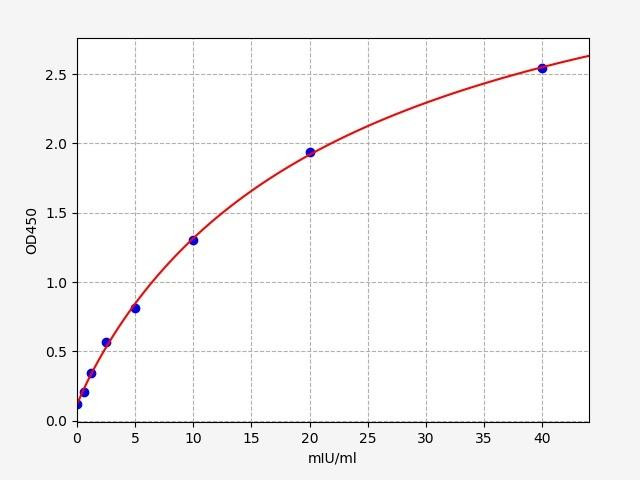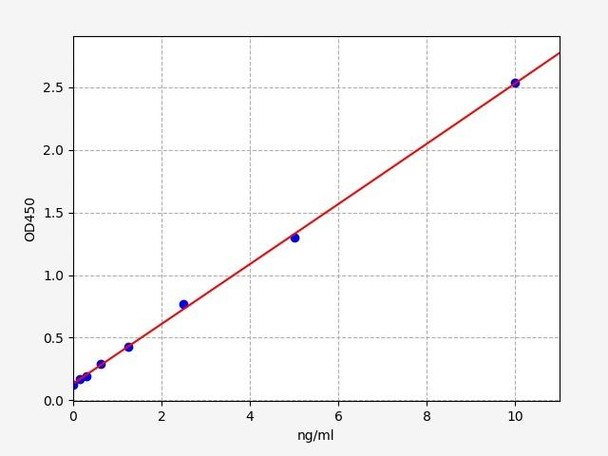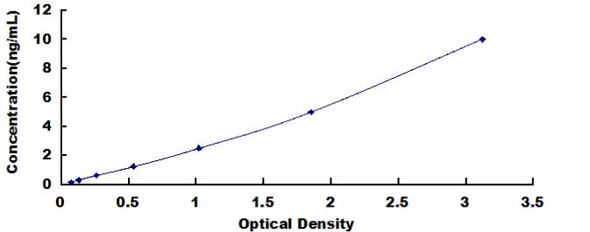Mouse Glutamate dehydrogenase / GDH ELISA Kit
- SKU:
- MOFI00853
- Product Type:
- ELISA Kit
- Size:
- 96 Assays
- Uniprot:
- Q8CFX1
- Sensitivity:
- 0.094ng/ml
- Range:
- 0.156-10ng/ml
- ELISA Type:
- Sandwich
- Synonyms:
- GDH, GLDH
- Reactivity:
- Mouse
- Research Area:
- Metabolism
Description
Mouse Glutamate dehydrogenase / GDH ELISA Kit
GDH is an enzyme found in various organisms, including mice. It plays a crucial role in the metabolism of the amino acid glutamate. The Mouse GDH ELISA Kit is specifically designed for the quantitative detection and measurement of Glutamate Dehydrogenase levels in mouse samples. This kit enables the investigation of GLUD1's role in cellular metabolism, energy production, and related research areas.
Key Features
| Save Time | Pre-coated 96 well plate | |
| Quick Start | Kit includes all necessary reagents | |
| Publication Ready | Reproducible and reliable results |
Overview
|
Product Name: |
Mouse Glutamate dehydrogenase / GDH ELISA Kit |
|
Product Code: |
MOFI00853 |
|
Size: |
96 Assays |
|
Alias: |
GDH, GLDH |
|
Detection Method: |
Sandwich ELISA |
|
Application: |
This immunoassay kit allows for the in vitro quantitative determination of Mouse GLDH concentrations in serum plasma and other biological fluids. |
|
Sensitivity: |
0.094ng/ml |
|
Range: |
0.156-10ng/ml |
|
Storage: |
4°C for 6 months |
|
Note: |
For Research Use Only |
Additional Information
|
Recovery |
Matrices listed below were spiked with certain level of Mouse GDH and the recovery rates were calculated by comparing the measured value to the expected amount of Mouse GDH in samples.
|
||||||||||||||||||||
|
Linearity: |
The linearity of the kit was assayed by testing samples spiked with appropriate concentration of Mouse GDH and their serial dilutions. The results were demonstrated by the percentage of calculated concentration to the expected.
|
||||||||||||||||||||
|
Intra Assay |
CV < 8% |
||||||||||||||||||||
|
Inter Assay |
CV < 10% |
Kit Components
| Component | Quantity | Storage |
|
ELISA Microplate (Dismountable) |
8x12 strips |
4°C for 6 months |
|
Lyophilized Standard |
2 |
4°C/ -20°C |
|
Sample/Standard Dlution Buffer |
20ml |
4°C |
|
Biotin-labeled Antibody (Concentrated) |
120ul |
4°C (Protection from light) |
|
Antibody Dilution Buffer |
10ml |
4°C |
|
HRP-Streptavidin Conjugate (SABC) |
120ul |
4°C (Protect from light) |
|
SABC Dilution Buffer |
10ml |
4°C |
|
TMB Substrate |
10ml |
4°C (Protection from light) |
|
Stop Solution |
10ml |
4°C |
|
Wash Buffer (25X) |
30ml |
4°C |
|
Plate Sealer |
5 |
- |
Other materials required:
- Microplate reader with 450 nm wavelength filter
- Multichannel Pipette, Pipette, microcentrifuge tubes and disposable pipette tips
- Incubator
- Deionized or distilled water
- Absorbent paper
- Buffer resevoir
Protocol
*Note: Protocols are specific to each batch/lot. For the exact instructions please follow the protocol included in your kit.
Before adding to wells, equilibrate the SABC working solution and TMB substrate for at least 30 min at 37°C. When diluting samples and reagents, they must be mixed completely and evenly. It is recommended to plot a standard curve for each test.
| Step | Procedure |
|
1. |
Set standard, test sample and control (zero) wells on the pre-coated plate respectively, and then, record their positions. It is recommended to measure each standard and sample in duplicate. Wash plate 2 times before adding standard, sample and control (zero) wells! |
|
2. |
Aliquot 0.1ml standard solutions into the standard wells. |
|
3. |
Add 0.1 ml of Sample / Standard dilution buffer into the control (zero) well. |
|
4. |
Add 0.1 ml of properly diluted sample ( Human serum, plasma, tissue homogenates and other biological fluids.) into test sample wells. |
|
5. |
Seal the plate with a cover and incubate at 37 °C for 90 min. |
|
6. |
Remove the cover and discard the plate content, clap the plate on the absorbent filter papers or other absorbent material. Do NOT let the wells completely dry at any time. Wash plate X2. |
|
7. |
Add 0.1 ml of Biotin- detection antibody working solution into the above wells (standard, test sample & zero wells). Add the solution at the bottom of each well without touching the side wall. |
|
8. |
Seal the plate with a cover and incubate at 37°C for 60 min. |
|
9. |
Remove the cover, and wash plate 3 times with Wash buffer. Let wash buffer rest in wells for 1 min between each wash. |
|
10. |
Add 0.1 ml of SABC working solution into each well, cover the plate and incubate at 37°C for 30 min. |
|
11. |
Remove the cover and wash plate 5 times with Wash buffer, and each time let the wash buffer stay in the wells for 1-2 min. |
|
12. |
Add 90 µl of TMB substrate into each well, cover the plate and incubate at 37°C in dark within 10-20 min. (Note: This incubation time is for reference use only, the optimal time should be determined by end user.) And the shades of blue can be seen in the first 3-4 wells (with most concentrated standard solutions), the other wells show no obvious color. |
|
13. |
Add 50 µl of Stop solution into each well and mix thoroughly. The color changes into yellow immediately. |
|
14. |
Read the O.D. absorbance at 450 nm in a microplate reader immediately after adding the stop solution. |
Sample Preparation
When carrying out an ELISA assay it is important to prepare your samples in order to achieve the best possible results. Below we have a list of procedures for the preparation of samples for different sample types.
| Sample Type | Protocol |
|
Serum |
If using serum separator tubes, allow samples to clot for 30 minutes at room temperature. Centrifuge for 10 minutes at 1,000x g. Collect the serum fraction and assay promptly or aliquot and store the samples at -80°C. Avoid multiple freeze-thaw cycles. If serum separator tubes are not being used, allow samples to clot overnight at 2-8°C. Centrifuge for 10 minutes at 1,000x g. Remove serum and assay promptly or aliquot and store the samples at -80°C. Avoid multiple freeze-thaw cycles. |
|
Plasma |
Collect plasma using EDTA or heparin as an anticoagulant. Centrifuge samples at 4°C for 15 mins at 1000 × g within 30 mins of collection. Collect the plasma fraction and assay promptly or aliquot and store the samples at -80°C. Avoid multiple freeze-thaw cycles. Note: Over haemolysed samples are not suitable for use with this kit. |
|
Urine & Cerebrospinal Fluid |
Collect the urine (mid-stream) in a sterile container, centrifuge for 20 mins at 2000-3000 rpm. Remove supernatant and assay immediately. If any precipitation is detected, repeat the centrifugation step. A similar protocol can be used for cerebrospinal fluid. |
|
Cell culture supernatant |
Collect the cell culture media by pipette, followed by centrifugation at 4°C for 20 mins at 1500 rpm. Collect the clear supernatant and assay immediately. |
|
Cell lysates |
Solubilize cells in lysis buffer and allow to sit on ice for 30 minutes. Centrifuge tubes at 14,000 x g for 5 minutes to remove insoluble material. Aliquot the supernatant into a new tube and discard the remaining whole cell extract. Quantify total protein concentration using a total protein assay. Assay immediately or aliquot and store at ≤ -20 °C. |
|
Tissue homogenates |
The preparation of tissue homogenates will vary depending upon tissue type. Rinse tissue with 1X PBS to remove excess blood & homogenize in 20ml of 1X PBS (including protease inhibitors) and store overnight at ≤ -20°C. Two freeze-thaw cycles are required to break the cell membranes. To further disrupt the cell membranes you can sonicate the samples. Centrifuge homogenates for 5 mins at 5000xg. Remove the supernatant and assay immediately or aliquot and store at -20°C or -80°C. |
|
Tissue lysates |
Rinse tissue with PBS, cut into 1-2 mm pieces, and homogenize with a tissue homogenizer in PBS. Add an equal volume of RIPA buffer containing protease inhibitors and lyse tissues at room temperature for 30 minutes with gentle agitation. Centrifuge to remove debris. Quantify total protein concentration using a total protein assay. Assay immediately or aliquot and store at ≤ -20 °C |
|
Breast Milk |
Collect milk samples and centrifuge at 10,000 x g for 60 min at 4°C. Aliquot the supernatant and assay. For long term use, store samples at -80°C. Minimize freeze/thaw cycles. |
GDH Background
Glutamate Dehydrogenase (GDH)
GDH is an enzyme found in various organisms, including mice. It plays a crucial role in the metabolism of the amino acid glutamate. In mice, the gene encoding GDH is referred to as the "Glud1 gene."
GDH Gene
In mice, GDH is encoded by the Glud1 gene located in chromosome 14 and containing 13 exons. It is expressed in a variety of tissues all over the body, and is ubiquitously expressed in liver.
Glutamate Dehydrogenase Structure
GDH is typically a hexameric enzyme, meaning it consists of six subunits (two trimers stacked on each other). Each subunit contains multiple domains responsible for binding to the enzyme's substrates and cofactors. The structure of GDH allows it to facilitate the conversion of glutamate and other molecules.
Glutamate Dehydrogenase Function
GDH is primarily involved in the interconversion between glutamate and α-ketoglutarate, which are important metabolites in various cellular processes. GDH serves both as an anabolic enzyme, incorporating nitrogen into amino acids, and as a catabolic enzyme, producing energy through the tricarboxylic acid (TCA) cycle. It helps to balance the levels of these metabolites in response to cellular energy needs and amino acid availability.
Glutamate Dehydrogenase Reaction:
The main reaction catalyzed by GDH is the reversible conversion of α-ketoglutarate and ammonia (NH₃) into glutamate, utilizing NAD⁺ or NADP⁺ as a cofactor:
α-ketoglutarate + NH₃ + NAD(P)⁺ ⇌ L-glutamate + NAD(P)H + H⁺
Glutamate Dehydrogenase Inhibitor:
Glutamate dehydrogenase (GDH) inhibitors are utilized for research and medical purposes to modulate the activity of the GDH enzyme. These inhibitors enable investigations into cellular metabolism, neurotransmitter regulation, and disease pathways. By targeting GDH, researchers can explore its role in metabolic processes, neurological disorders, cancer growth, and mitochondrial function. GDH inhibitors also aid drug development, serving as tools to manipulate cellular functions and study nutrient-metabolism interactions. While offering valuable insights, the use of GDH inhibitors requires careful consideration of their broad impact on cellular processes and potential applications in various research and therapeutic contexts.
Mouse GDH ELISA Kit FAQs
Q: What is the purpose of the Mouse GDH ELISA Kit?
The Mouse GDH ELISA Kit is specifically designed for the quantitative detection and measurement of Glutamate Dehydrogenase levels in mouse samples. It provides researchers with a reliable and convenient tool to assess GDH protein expression levels in various biological samples, such as serum, plasma, cell lysates, and tissue homogenates. This kit enables the investigation of GDH role in cellular metabolism, energy production, and related research areas.
Q: What type of samples can be used with the mouse GDH ELISA kit?
The Mouse GDH ELISA Kit is suitable for the measurement of GDH levels in various sample types, including serum, plasma, cell lysates, and tissue homogenates. It provides flexibility for researchers working with different sample sources to assess GDH expression levels in a wide range of experimental setups.
Q: Are the Mouse GDH ELISA Kits compatible with other species?
The Mouse GDH ELISA Kits are specifically designed and validated for the measurement of GDH levels in mouse samples. While it is optimized for mouse samples, it may not be suitable for other species without proper validation. If you are working with samples from other species, it is recommended to consult with the manufacturer or refer to specific ELISA kits designed for those species.
Q: Where can I find additional technical support or assistance with the kit?
For any technical inquiries or assistance regarding the kit, you can reach out to our team. They will be available to answer your questions and provide the necessary guidance to ensure a successful experiment.
Related Products

| Mouse Glutamate dehydrogenase 1, mitochondrial (Glud1) ELISA Kit | |
|---|---|
| ELISA Type: | Sandwich |
| Reactivity: | Mouse |
| Size: | 96 Assays |

| Human GLUD1 / Glutamate dehydrogenase 1 ELISA Kit | |
|---|---|
| ELISA Type: | Sandwich |
| Sensitivity: | 0.375mIU/ml |
| Range: | 0.625-40mIU/ml |







